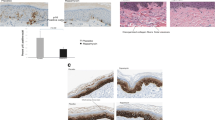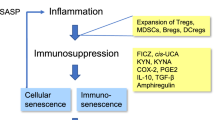Abstract
Human papillomaviruses (HPVs) are known to utilize the down-regulation of epithelial (E)-cadherin, a major component of adherens junctions of keratinocytes, to evade host immune surveillance in high-risk group. However, the effects of HPV on the function of E-cadherin in low-risk groups remain unknown. We investigated whether type 2 HPV (HPV-2) E7 could induce alterations in E-cadherin expression in transiently transfected keratinocytes and cell lines expressing HPV-2 E7. To examine the expression pattern of E-cadherin in cutaneous warts and normal skin samples, immunohistochemical analysis was performed. Quantitative real-time polymerase chain reactions, luciferase assays, western blot, immunocytochemistry, and electron microscopy were used to evaluate the mRNA and protein expression levels of E-cadherin in normal human epidermal keratinocytes transfected with HPV-2 E7 plasmid DNA or E7-specific siRNA and in E7-expressing cell lines. E-cadherin expression levels in HPV-2 positive cutaneous warts were significantly decreased compared to those in normal skin (p < 0.05). Similarly, the mRNA and protein expression levels of E-cadherin in E7 transiently transfected cells were significantly decreased compared to those in empty vector-transfected cells. The decreases were restored by transfection with E7-specific siRNA (p < 0.05). Likewise, cell lines expressing E7 showed a decreased expression of E-cadherin. When the cells were cultured in low attachment plates, cell-to-cell aggregation was inhibited. Taken together, our data suggest that HPV-2 E7, the causative agent of cutaneous warts, could mediate the transcriptional repression of E-cadherin.
Similar content being viewed by others
References
Aberle, H., Schwartz, H., and Kemler, R. 1996. Cadherin-catenin complex: protein interactions and their implications for cadherin function. J. Cell. Biochem. 61, 514–523.
Amador-Molina, A., Hernandez-Valencia, J.F., Lamoyi, E., Contreras-Paredes, A., and Lizano, M. 2013. Role of innate immunity against human papillomavirus (HPV) infections and effect of adjuvants in promoting specific immune response. Viruses 5, 2624–2642.
Arora, P., Kim, E.O., Jung, J.K., and Jang, K.L. 2008. Hepatitis C virus core protein downregulates E-cadherin expression via activation of DNA methyltransferase 1 and 3b. Cancer Lett. 261, 244–252.
Birchmeier, W. and Behrens, J. 1994. Cadherin expression in carcinomas: role in the formation of cell junctions and the prevention of invasiveness. Biochim. Biophys. Acta 1198, 11–26.
Bordignon, V., Di Domenico, E.G., Trento, E., D’Agosto, G., Cavallo, I., Pontone, M., Pimpinelli, F., Mariani, L., and Ensoli, F. 2017. How human papillomavirus replication and immune evasion strategies take advantage of the host DNA damage repair machinery. Viruses 9, 390.
Burgers, W.A., Blanchon, L., Pradhan, S., de Launoit, Y., Kouzarides, T., and Fuks, F. 2007. Viral oncoproteins target the DNA methyltransferases. Oncogene 26, 1650–1655.
Caberg, J.H., Hubert, P.M., Begon, D.Y., Herfs, M.F., Roncarati, P.J., Boniver, J.J., and Delvenne, P.O. 2008. Silencing of E7 oncogene restores functional E-cadherin expression in human papillomavirus 16-transformed keratinocytes. Carcinogenesis 29, 1441–1447.
Ci, X., Zhao, Y., Tang, W., Tu, Q., Jiang, P., Xue, X., Saunders, N.A., Zhang, L., Zhu, X., and Zhao, K.N. 2020. HPV16 E7-impaired keratinocyte differentiation leads to tumorigenesis via cell cycle/pRb/involucrin/spectrin/adducin cascade. Appl. Microbiol. Biotechnol. 104, 4417–4433.
Crowe, A.R. and Yue, W. 2019. Semi-quantitative determination of protein expression using immunohistochemistry staining and analysis: an integrated protocol. Bio Protoc. 9, e3465.
D’Costa, Z.J., Jolly, C., Androphy, E.J., Mercer, A., Matthews, C.M., and Hibma, M.H. 2012. Transcriptional repression of E-cadherin by human papillomavirus type 16 E6. PLoS ONE 7, e48954.
de Koning, M.N.C., ter Schegget, J., Eekhof, J.A.H., Kamp, M., Kleter, B., Gussekloo, J., Feltkamp, M.C.W., Bouwes Bavinck, J.N., Purdie, K.J., Bunker, C.B., et al. 2010. Evaluation of a novel broad-spectrum PCR-multiplex genotyping assay for identification of cutaneous wart-associated human papillomavirus types. J. Clin. Microbiol. 48, 1706–1711.
de Villiers, E.M., Fauquet, C., Broker, T.R., Bernard, H.U., and zur Hausen, H. 2004. Classification of papillomaviruses. Virology 324, 17–27.
Grabowska, A.K. and Riemer, A.B. 2012. The invisible enemy — how human papillomaviruses avoid recognition and clearance by the host immune system. Open Virol. J. 6, 249–256.
Hellner, K., Mar, J., Fang, F., Quackenbush, J., and Münger, K. 2009. HPV16 E7 oncogene expression in normal human epithelial cells causes molecular changes indicative of an epithelial to mesenchymal transition. Virology 391, 57–63.
Laurson, J., Khan, S., Chung, R., Cross, K., and Raj, K. 2010. Epigenetic repression of E-cadherin by human papillomavirus 16 E7 protein. Carcinogenesis 31, 918–926.
Lee, J.O., Kwun, H.J., Jung, J.K., Choi, K.H., Min, D.S., and Jang, K.L. 2005. Hepatitis B virus X protein represses E-cadherin expression via activation of DNA methyltransferase 1. Oncogene 24, 6617–6625.
Leong, C.M., Doorbar, J., Nindl, I., Yoon, H.S., and Hibma, M.H. 2010a. Deregulation of E-cadherin by human papillomavirus is not confined to high-risk, cancer-causing types. Br. J. Dermatol. 163, 1253–1263.
Leong, C.M., Doorbar, J., Nindl, I., Yoon, H.S., and Hibma, M.H. 2010b. Loss of epidermal Langerhans cells occurs in human papillomavirus a, γ, and μ but not β genus infections. J. Invest. Dermatol. 130, 472–480.
Leong, C.M. and Hibma, M.H. 2005. A flow cytometry-based assay for the measurement of protein regulation of E-cadherin-mediated adhesion. J. Immunol. Methods 302, 116–124.
Leto, M., Santos Júnior, G.F., Porro, A.M., and Tomimori, J. 2011. Human papillomavirus infection: etiopathogenesis, molecular biology and clinical manifestations. An. Bras. Dermatol. 86, 306–317.
Livak, K.J. and Schmittgen, T.D. 2001. Analysis of relative gene expression data using real-time quantitative PCR and the 2−ΔΔCT method. Methods 25, 402–408.
Matthews, K., Leong, C.M., Baxter, L., Inglis, E., Yun, K., Bäckström, B.T., Doorbar, J., and Hibma, M. 2003. Depletion of Langerhans cells in human papillomavirus type 16-infected skin is associated with E6-mediated down regulation of E-cadherin. J. Virol. 77, 8378–8385.
Milner, D.A. 2015. Human Papillomavirus Infection. In Diagnostic Pathology: Infectious Diseases, 1st edn., pp. 40–49. Elsevier, Kidlington, Oxford, United Kingdom.
Pal, A. and Kundu, R. 2020. Human papillomavirus E6 and E7: the cervical cancer hallmarks and targets for therapy. Front. Microbiol. 10, 3116.
Ranjeva, S.L., Baskerville, E.B., Dukic, V., Villa, L.L., Lazcano-Ponce, E., Giuliano, A.R., Dwyer, G., and Cobey, S. 2017. Recurring infection with ecologically distinct HPV types can explain high prevalence and diversity. Proc. Natl. Acad. Sci. USA 114, 13573–13578.
Reinhold, W.C., Reimers, M.A., Maunakea, A.K., Kim, S., Lababidi, S., Scherf, U., Shankavaram, U.T., Ziegler, M.S., Stewart, C., Kouros-Mehr, H., et al. 2007. Detailed DNA methylation profiles of the E-cadherin promoter in the NCI-60 cancer cells. Mol. Cancer Ther. 6, 391–403.
Roger, L., Jullien, L., Gire, V., and Roux, P. 2010. Gain of oncogenic function of p53 mutants regulates E-cadherin expression uncoupled from cell invasion in colon cancer cells. J. Cell Sci. 123, 1295–1305.
Rosendo-Chalma, P., Antonio-Vejar, V., Bigoni-Ordóñez, G.D., Patiño-Morales, C.C., Cano-García, A., and García-Carrancá, A. 2020. CDH1 and SNAI1 are regulated by E7 from human papillomavirus types 16 and 18. Int. J. Oncol. 57, 301–313.
Shimoyama, Y., Hirohashi, S., Hirano, S., Noguchi, M., Shimosato, Y., Takeichi, M., and Abe, O. 1989. Cadherin cell-adhesion molecules in human epithelial tissues and carcinomas. Cancer Res. 49, 2128–2133.
Tang, A., Amagai, M., Granger, L.G., Stanley, J.R., and Udey, M.C. 1993. Adhesion of epidermal Langerhans cells to keratinocytes mediated by E-cadherin. Nature 361, 82–85.
Tsai, C.N., Tsai, C.L., Tse, K.P., Chang, H.Y., and Chang, Y.S. 2002. The Epstein-Barr virus oncogene product, latent membrane protein 1, induces the downregulation of E-cadherin gene expression via activation of DNA methyltransferases. Proc. Natl. Acad. Sci. USA 99, 10084–10089.
Wakita, H., Yamamoto, Y., and Furukawa, F. 2003. Aberrant suprabasal P-cadherin expression in acanthotic but not psoriatic thickened epidermis. Arch. Dermatol. Res. 295, S71–S74.
zur Hausen, H. 2002. Papillomaviruses and cancer: from basic studies to clinical application. Nat. Rev. Cancer 2, 342–350.
Acknowledgements
We gratefully acknowledge Yang Hoon Huh for helping to perform the immune-EM analysis. This research was supported by a grant (2011-0010754) from the Basic Science Research Program through the National Research Foundation (NRF) funded by the Ministry of Education, Republic of Korea. It was also supported by the 2013 Hannam University Research Fund.
Author information
Authors and Affiliations
Corresponding author
Ethics declarations
Conflict of Interest The authors declare no conflicts of interest.
Ethics Statement All experimental procedures of this study were approved by the Institutional Review Board of Hannam University (IRB no. 14-02-02-0502).
Additional information
Supplemental material for this article may be found at http://www.springerlink.com/content/120956.
Electronic supplementary material
Rights and permissions
About this article
Cite this article
Song, J.Y., Park, Y.M. & Choi, S.Y. Type 2 human papillomavirus E7 attenuates E-cadherin expression in human keratinocytes. J Microbiol. 59, 616–625 (2021). https://doi.org/10.1007/s12275-021-0690-y
Received:
Revised:
Accepted:
Published:
Issue Date:
DOI: https://doi.org/10.1007/s12275-021-0690-y




